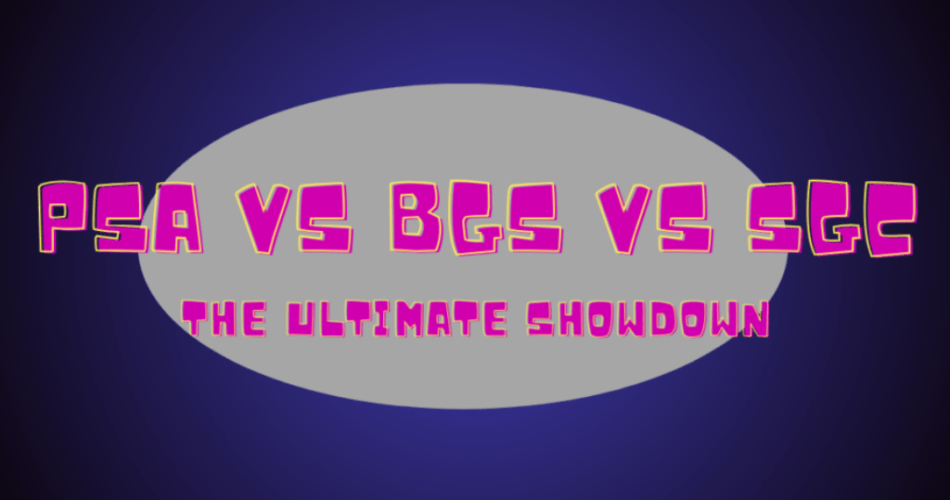Over the past few decades, the sports card trading and collectibles market has experienced massive growth. Buyers now flock to online marketplaces like eBay and Amazon to purchase cards of their favorite professional athletes and for good reason.
Think about Michael Jordan, for example, widely regarded as the best basketball player of all time. Sports card collectors interested in the NBA would likely pick up Michael Jordan error cards for nostalgia, accumulating a pile of collectibles, each representing the best moments of his successful career. These particular collectibles serve as a fond reminder of how talented the Chicago Bulls shooting guard was on the court.
With some prestigious cards selling for thousands of dollars, a new landscape of sports card grading companies arose to give greater attention and importance to the overall condition and authenticity of cards listed on the market.
Sellers of sports trading cards want to maximize their profits by preserving hobby boxes containing rare or limited-edition card sets.
This is where the previously mentioned grading companies generate most of their business. Card owners looking to make significant bucks would submit their items for evaluation and rating by a reputable third party, as scoring good card grades can significantly boost their market value.
This article’ll examine the differences between two prominent sports card grading companies – Professional Sports Authenticator (PSA) and Becket Grading Services (BGS).
We shall highlight the differences between each company’s card grading methodology, covering different elements like:
- Card centering;
- Corners and edges;
- Surface condition; together with
- Authenticity and encapsulation
This in-depth piece will also highlight each company’s unique features and advantages, as well as present a detailed comparison of their card grading turnaround times.
In addition, we will analyze the grading fees and cost structures of both services and evaluate the accuracy and consistency of grade tiers assigned by each provider.
Finally, we shall conclude with a precise verdict on which of the two sports card grading companies is better, complete with factual justification and evidence-based reasoning.
So, let’s get started!
Brief Background
As this article intends to serve as a detailed comparison between the two card and collectible grading services, we’ll spare you the long history lesson concerning the founding and gradual establishment of these card grading and authentication powerhouses.
Instead, here’s a little overview of what each company is about.
1. PSA
Professional Sports Authenticator is the largest third-party trading card authentication and grading company in the world. Since its inception in 1991, the company has certified over 40 million cards and collectables with a cumulative declared value exceeding a billion dollars.
The brand promises to continuously provide an impartial and experienced authentication of trading cards and collectibles, founded on important principles of value, security and education.
Whether you fall into the buyer or seller category, there’s a high likelihood you’ll have come across their red and white graded slabs, accompanied by a 10-point rating scale that has become synonymous with card grading over time.
2. Beckett Grading Services
On the other hand, BGS was brought to life by an American statistician called Dr. James Beckett. The man had developed a reputation as an excellent price guide publisher; releasing his first Sport Americana Baseball Card Price Guide book in 1979.
Under his guidance, Beckett Media mastered the print medium, expanded price guide titles to other sports and genres, introduced web commerce as a viable means of trade and instituted grading as an important segment of the company portfolio.
Their card grading services have become one of the most recognized in the industry because of their objectivity, authenticity verification, and state-of-the-art protection features for long-term archiving.
Concerning their grading standards, BGS offers color-coded tags for the cards based on their grade. So, for instance, a gold color tag indicates a card with a 9.5 or 10 grade. They also implement sub-scores, which offer greater granularity concerning the card’s performance in each of their four subcategories (i.e. centering, corners, surface, and edges).
In addition, BGS also has a “Black Label” status awarded to perfect cards that score maximum ratings of 10 in each of the previously mentioned subcategories.
3. SGC
SGC grading refers to the grading services provided by SGC (Sportscard Guaranty Corporation), which is a company that specializes in the authentication and grading of sports cards. Sports cards are collectible cards featuring athletes, teams, or events, and grading services help assess the condition and authenticity of these cards.
SGC evaluates sports cards using a numerical grading scale, with higher grades indicating better condition. The grading process involves examining factors such as centering, corners, edges, and surface quality. Additionally, SGC provides authentication services to ensure that the sports cards are genuine and have not been altered.
Collectors often seek graded sports cards as they provide a standardized and reputable assessment of the card’s condition, making buying, selling, and trading within the hobby easier. SGC is one of several grading companies in the sports card industry, alongside others like PSA (Professional Sports Authenticator) and Beckett Grading Services.
Card grading criteria used
Both companies use a 10-point grading scale to evaluate the overall condition of a card.
With PSA, the grades range from the highest tier (i.e. PSA 10) to the lowest (PSA 1), with a half-point marker for near-mint cards (i.e. 8.5).
Here are all the PSA grades in descending order of quality:
- GEM-MT: PSA 10
- MINT: PSA 9
- NM-MT: PSA 8
- NM: PSA 7
- EX-MT: PSA 6
- EX: PSA 5
- VG-EX: PSA 4
- VG: PSA 3
- GOOD: PSA 2
- FR: PSA 1.5
- PR: PSA 1
A PSA 10 card is virtually perfect, with four perfectly sharp corners, sharp focus, full original gloss, and no staining of any kind except for printing imperfections.
More so, the image of this perfect quality card must also be centered on it with a tolerance that shouldn’t exceed approximately 55/45 to 60/40 per cent on the front, and 75/25 per cent on the reverse end.
Conversely, BGS have a more detailed grading scale that offers half-point ratings, which provides a more nuanced understanding of a card’s overall condition and quality.
Furthermore, top-graded cards receive color-coded labels that enhance the uniformity of collections and create recognizable points of reference for interested buyers.
For instance, cards graded 8 or below receive a silver label, whereas cards with ratings of 9.5 or 10 get a gold-colored plating added.
BGS are also known to rarely issue grade 10 ratings, which they call a “Pristine 10”.
Here’s what this BGS grading scale looks like, in descending order of quality:
- Pristine 10 Black
- 10 Gold
- Gem Mint 9.5
- Mint 9
- Near Mint/Mint 8
- Near Mint 7
- Excellent Mint 6
- Excellent 5
- Very Good/Excellent 4
- Very Good 3
- Good 2
- Poor 1
Both companies take the different card elements (e.g., centering, cornering, surface wear, and print quality) into account when grading, so you may be wondering where they differ in practice.
Well, the main difference is that PSA uses a point system to determine the overall grade of a card, whereas BGS uses a more subjective approach that relies on human judgment.
In addition, PSA is known to use a proprietary machine to accurately measure a card’s centering, while BGS again relies on human intuition and experience. This can result in different grade scores for the same card.
Although most collectors consider the highest grading tiers for each of these companies as the same, the market pricing for a PSA 10 card and a BGS 10 can be considerably different.
SGC Grading Scale
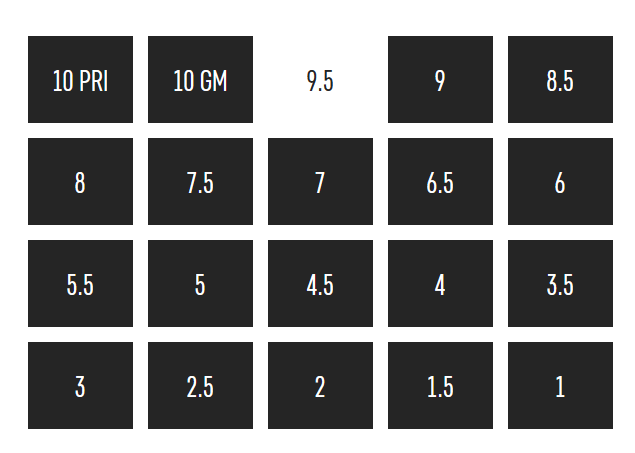
- 10 Pristine: A “virtually flawless” card. 50/50 centering, crisp focus, four sharp corners*, free of stains, no breaks in surface gloss, no print or refractor lines, and no visible wear under magnification.
- 10 Gem: 55/45 or better centering, sharp focus, four sharp corners*, free of stains, no breaks in surface gloss, no print or refractor lines, and no visible wear. A slight print spot visible under scrutiny is allowable if it does not detract from the card’s aesthetics.
- 9.5: This is a card that at first glance appears to be Gem Mint 10 upon close inspection it may have a tiny flaw(s) that keeps it from grading GEM MT 10.
- 9: 60/40 or better centering, sharp focus, and four sharp corners*. A minor flaw may exist upon close examination. A minor flaw may be but is not limited to a slight nick to one corner, a small gloss break or surface scratch, a minor print line or minor refractor line, a minor focus or color imperfection, or a small print spot.
Anything less than an SGC 9 garde is not worth purchasing in my opinion. But some may feel otherwise. Please visit SGC Grading Scale (gosgc.com) to see a complete SGC grading scale from 10 to 1.
Which cards have a better case design?
When it comes to card presentation, PSA and BGS certainly handle things differently.
PSA are highly regarded for the clarity and appearance of their Lighthouse labels, which come in standard white color with larger text than BGS labels.
Many collectors feel that the sparseness of PSA labels allows a greater spotlight for the photo and composition of the cards, which stand out more to the naked eye.
On the other hand, some people dislike PSA labels’ plainness and lack of subcategories that add greater complexity to the grading levels.
BGS has received several plaudits for its color-coded labeling process, with collectors appreciative of the ability to instantly recognize the quality of a card through its gold or silver plating.
You have the ultimate collector’s item when you include the coveted black label, which offers a unique aesthetic that sets these cards apart in the market.
This label symbolizes the pinnacle of card condition, where a BGS-graded card scores four perfect 10 ratings for centering, corners, edges, and surface conditions.
Although there are a few dissenting voices who call the lack of uniformity for BGS cards into question, often highlighting a lack of visual appeal when cards of different grades are displayed next to one another.
More specifically, the dark background of Beckett’s black labels is a notable drawback, as some collectors point out that the finer details can be difficult to read on such cards
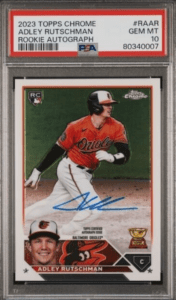
PSA 10 Design
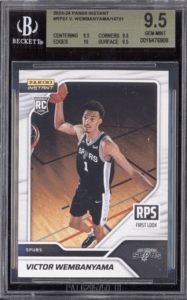
BGS 9.5 Design
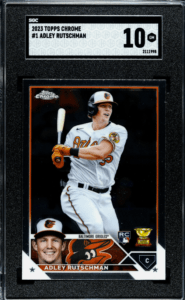
SGC 10 Design
BGS cards are said to come with superior slabs than those used by PSA, as they have a reputation for providing sturdier slabs equipped to deal with UV light.
The cards are packaged with a penny sleeve for additional protection, which helps with overall preservation as they are kept more securely in place.
PSA receives a fair amount of criticism in this department, as some collectors report that PSA cards will “slide around” a bit if the slab is shaken. However, there’s yet to be widespread news about these shaky slabs causing damage to the cards that rest inside.
SGC is a basic black-and-white design. I like this design, although many people in the collecting world disagree with me.
Turnaround times for PSA, BGS, & SGC
Once you submit cards to either of these two companies for grading, you’ll have to wait for them to be returned.
PSAs naturally have longer waiting times for card grading, as they’re the overwhelmingly popular choice for most collectors.
As previously mentioned, they’ve graded over 40 million cards and collectibles since inception in 1991. With the historically high demand for their services continuing into the present day, you can expect a fairly long turnaround time.
Meanwhile, BGS has a proven track record for fast card grading and more affordable services.
So, if you want to have your cards graded and promptly returned to quickly trade or sell them, Beckett is the optimal choice here.
SGC has a 5 to 10 days or a 1 to 2 day turnaround time.
BGS
- Relabel: 10-15 business days
- Collectors Special: 40-60 business days
- Base: 40 to 60 business days
- Standard: 10 to 20 business days
- Priority: 2 to 5 business days
- Next Day: 1 business day
- Immediate: Same day
SGC
- 5 to 10 business days on all orders
- 1 to 2 business days if the buyer pays extra for express shipping
Card grading fees comparison
Having a look through both company websites paints a clear picture of the pricing that these two card graders have to offer.
BGS has a less complicated offering, with five distinguishable tiers for customers to choose. These are as follows:
- Collectors’ Special – $18 per card; $16 per card without subgrades and a turnaround time of 60+ business days
- Base – $22 per card; $18 per card without subgrades and a turnaround time of 60+ business days
- Standard – $40 per card; $30 per card without subgrades and a turnaround time of 10 to 20 business days
- Express – $100 per card; $80 per card without subgrades and a turnaround time of 10 business days
- Priority – $140 per card; $100 per card without subgrades and a turnaround time of 2 to 5 business days
BGS offers a more cost-effective option for grading your cards and doesn’t tie your fees to the declared value of your cards.
Ultimately, this makes for a straightforward fee system that offers value at both ends of the pricing spectrum.
Separately, PSA’s grading fees are expensive. The company also adds a layer of pricing complexity by charging customers based on the declared value of their cards.
For starters, their cheapest tier costs $25 per card, while on the other end of the scale, their Walk-Through tier requires customers to fork out a staggering amount of $600 per card, with the promise of an estimated turnaround time of 3 business days.
Here’s a breakdown of these six tiers:
- Value – $25 per card with a turnaround time of 65 business days
- Value Plus – $40 per card with a turnaround time of 20 business days
- Regular – $75 per card with a turnaround time of 10 business days
- Express – $150 per card with a turnaround time of 5 business days
- Super Express – $300 per card with a turnaround time of 3 business days
- Walk Through – $600 per card with a turnaround time of 3 business days
However, PSA also has two special pricing tiers. The Trading Card Game Bulk and Value Bulk tiers – respectively priced at $15 per card and $19 per card – have a turnaround time of 65 business days and are exclusive to members of their PSA Collectors Club.
This membership offers collectors unique perks like exclusive grading benefits and access to the company’s magazine, which explores trending card collector stories and delivers exclusive variant covers and special editions.
What’s even more impressive is the fantastic $120 signing bonus to Loupe – a streaming platform for live card breaks with vetted shops.
Pro-Tip: If you want the best return on your money go with PSA (90% of card grades should use PSA). Who cares if it takes a few days/week longer? What matters is the ROI.
All in all, you can get unbeatable prices per card if you sign up for PSA’s membership program for dedicated collectors, which also comes with several other benefits that may prove worthwhile.
SGC is the cheapest of the three, charging $15 for a card worth less than $1,500 (5 to 10 days) and $40 for a card valued at $1,500 or less for a 1 to 2-day turnaround.
If you want the card super fast and super cheap go with SGC.
Which cards have better resale value
One of the most important aspects of sports card collecting is the resale value, which determines what selling price you’ll receive for your cards once graded.
Collectors will want to maximize their return on investment by ensuring they can sell the card for as much as they paid for it, with a hefty profit mark-up percentage.
When it comes to the topic of how much money PSA and BGS cards sell for, both companies have their own set of advantages and drawbacks.
Firstly, cards with a PSA 10 grade are likely to sell for more money than BGS 9 grade cards, which makes sense because you’re getting a card in slightly better overall condition.
PSA also appears to have an edge on direct comparisons between cards of the same grade. This fantastic 2000 Bowman Chrome Tom Brady rookie card had a PSA 9 copy sell for $135,000 in February 2022. Meanwhile, the same BGS 9 grade card sold for $ 113,000 a month earlier in January 2022.
Now, that’s a steep $22,000 price difference, which shows that PSA cards hold greater value once they’re graded.
However, where the resale value scales tip in favor of Beckett and its grading system is when you consider BGS 10 grade cards, otherwise known as the “Pristine 10’s”. These black-label cards can sell for considerably higher sums than a comparative PSA 10 grade because they’re much rarer.
BGS 10 cards are a collector’s dream, as their exceptional status is well reflected in higher selling prices. The black label adds a monumental amount of exclusivity to the card in question, transforming even the most common card into a highly coveted piece of memorabilia once graded as such.
All in all, PSA has resale value in the bag because its graded cards have a higher price floor than its BGS-graded competitors. PSA cards should command higher overall fees when sold at auctions or through online marketplaces such as eBay and Amazon.
Although BGS 10 cards outperform PSA 10 grades, black labels are so rare that they’re not a good point of comparison.
Final recommendation
Both PSA and Beckett are excellent options as card grading service providers. They each have established processes and criteria for evaluating the overall condition of these items.
SGC, without a doubt, places third out of the three,
Considering all the factors discussed, we can vouch for PSA as they provide the best bang for your buck. Because of their storied history and massive grading volumes handled over the past couple of decades, they have cemented themselves as the gold standard for grading services.
Taking all the factors discussed into consideration, we can vouch for PSA as they provide the best bang for your buck.
PSA also has a huge community of collectors and dealers who trust and rely on their grading services, which makes it easier for you as a seller to pawn off or trade your cards once evaluated.
Despite their long wait times, PSA cards guarantee greater resale values, making the grading process well worth the wait. Ultimately, the amount of profit in your pocket is what truly matters.
